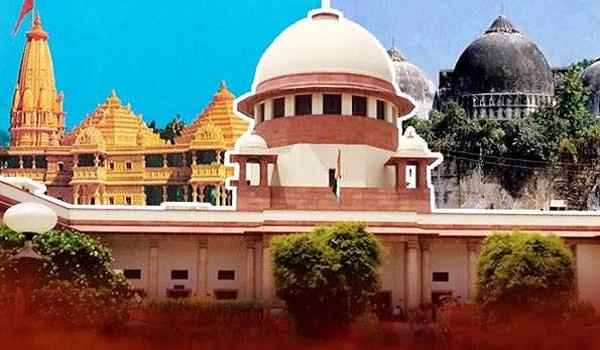New Delhi, October 09: The five-member Constitution Bench of the Supreme Court has given the much-awaited verdict on the Ayodhya case on Saturday. The court’s decision has cleared the way for construction of Ram temple at the birthplace of Lord Ram in Ayodhya. The court said that it is a clear decision to build a temple on the disputed land. Muslims will be given alternative land for the mosque. This is the essence of the verdict.
The bench headed by Chief Justice Ranjan Gogoi comprises Justice SA Bobde, Justice DY Chandrachud, Justice Ashok Bhushan and Justice SA Nazir.
The bench said that the Allahabad High Court’s decision that land should be given to Sunni Waqf Board and Nirmohi Akhara is wrong. It is not right for the court to consider theology. The basis of the constitution is secularism. Appeal of Nirmohi Akhara dismissed. Ram Janmabhoomi is not a judicial person, the deity is a judicial person. The Places of Worship Act is intended to protect the interests of people of all religions. ASI’s findings cannot be doubted. The evidence of ASI points to Hindu origin.
It is not clear from the findings of ASI that the Hindu temple was demolished and built a mosque. Ownership over land cannot be decided on the basis of ASI’s findings, but rather according to the provisions of the law.
The Supreme Court said that there is no dispute that Najul owned the land. The belief of Hindus that Lord Rama was born there is no dispute.
There is no evidence that the kitchen of Rama Chabutara and Sita were worshiped before the British arrived. Ownership of land cannot be decided on the basis of traveler and gazetteer.
Sunni Waqf Board’s claim rejected The Sunni Waqf Board also could not prove its other claim. The Muslim side failed to prove that it was in possession even before the Babri Masjid was built. Muslims should be given alternate land. The disputed land should be given to the center. Within three months, the central government will set up a trust and provide land both outside and inside for the construction of the temple.
10.39 AM: Flash ….. Supreme Court dismisses Education Waqf Board’s claim against Sunni Waqf Board
Flash …. flash …
10.40AM: Babri Masjid Mir Baqi was built by the Supreme Court.
10.47: There was a temple first, Babri Masjid was not built on empty land, Sunni Waqf Board’s argument rejected
10.48 AM: Secularism is the basis of constitution: Supreme Court
11.02AM: Ram was born in Ayodhya, there is no dispute in it- Supreme Court
11.05AM: It is not right for the court to consider theology.
Flash..flash ..
Ram was born in Ayodhya, there is no dispute in it- Supreme Court
No evidence of worship of Ram Chabutra and Sita Rasoi: Supreme Court
In its judgment on the Ayodhya dispute, the Supreme Court said that there is no evidence that Ram Chabutara and Sita used to worship the kitchen before the British arrived. Ownership of land cannot be decided on the basis of traveler and gazetteer. The mosque was not abandoned by the Muslims. Where Muslims used to offer Namaz inside, Hindus worshiped outside. Muslims used to face obstacles in offering namaz, but despite that they went inside and offered namaz, which meant that they did not leave the mos
However, the mosque was demolished in 1992 in violation of the Supreme Court order. Sunni Waqf Board’s claim rejected The Sunni Waqf Board could not prove its other claim. The Muslim side failed to prove that it was in possession even before the Babri Masjid was built. Muslims should be given alternate land.
Disputed land should be given to central government in Ayodhya: Supreme Court
The Supreme Court in its judgment on the Ayodhya dispute said that the disputed land should be given to the central government. Within three months, the central government will set up a trust and provide land both outside and inside for the construction of the temple. The court also said that the Allahabad High Court’s decision that land should be given to Sunni Waqf Board and Nirmohi Akhara is wrong. The Supreme Court has a clear verdict on building the temple on the disputed land. Muslims will be given an alternative 5 acres of land for the mosque. This is the essence of the verdict.





